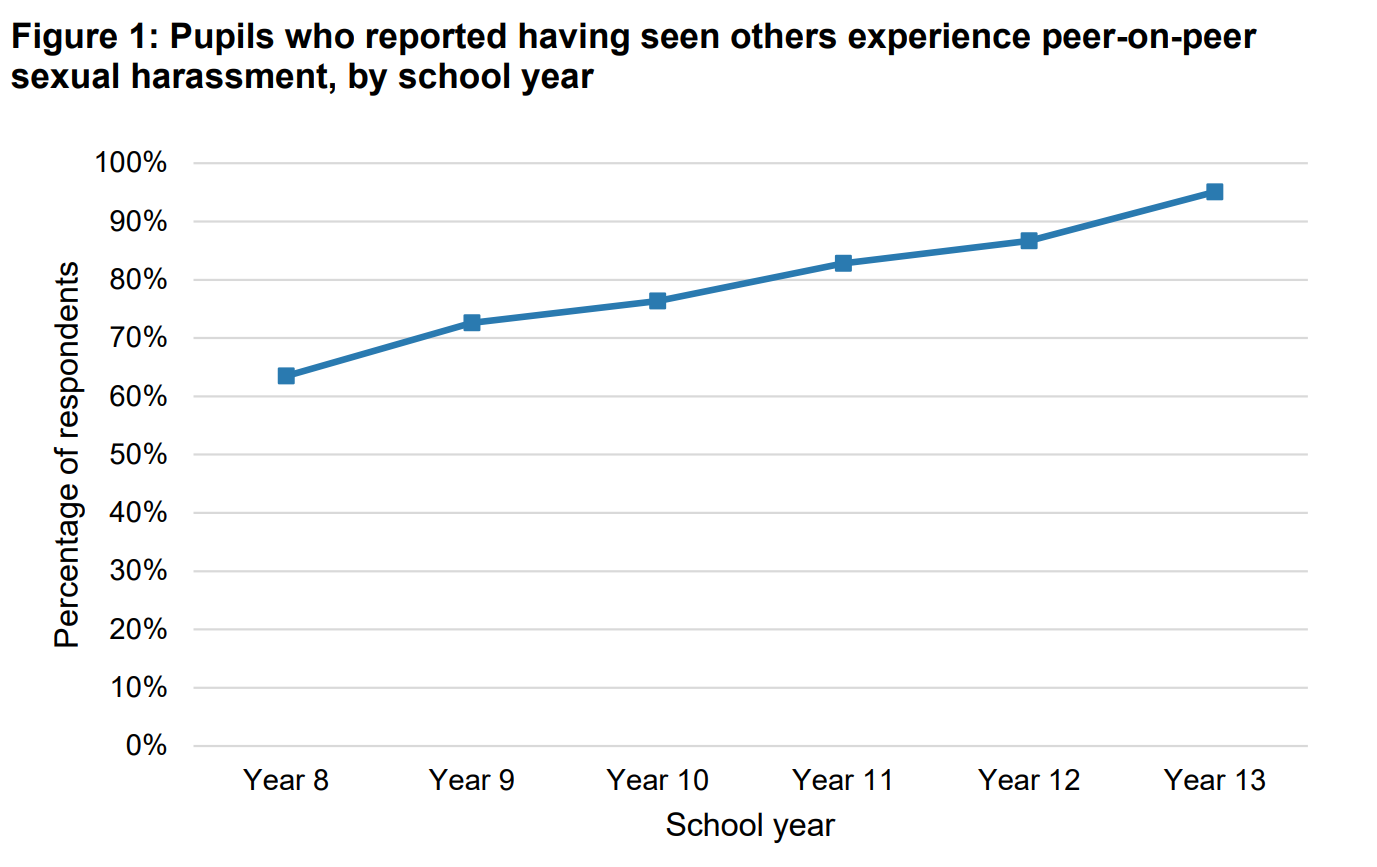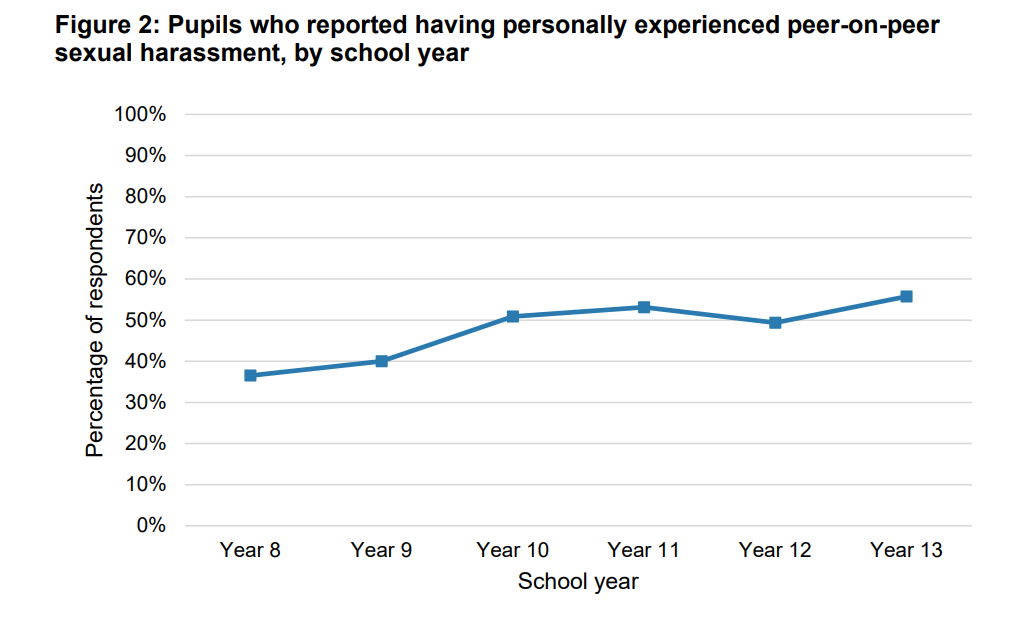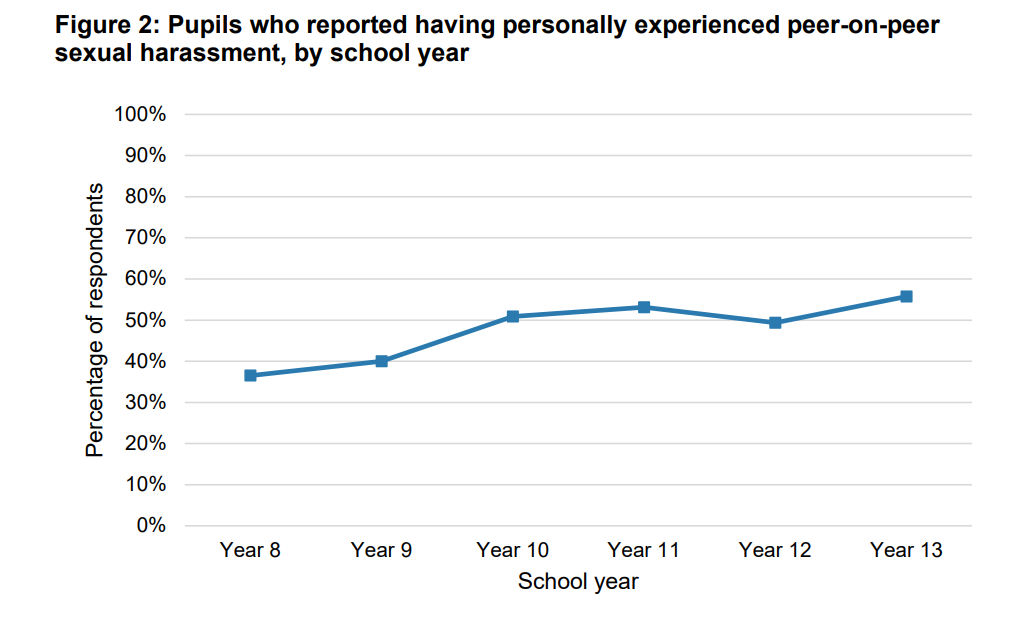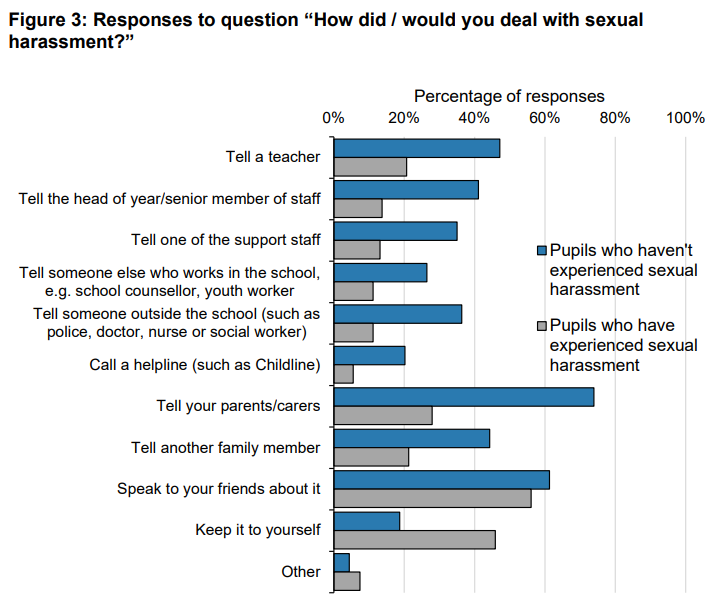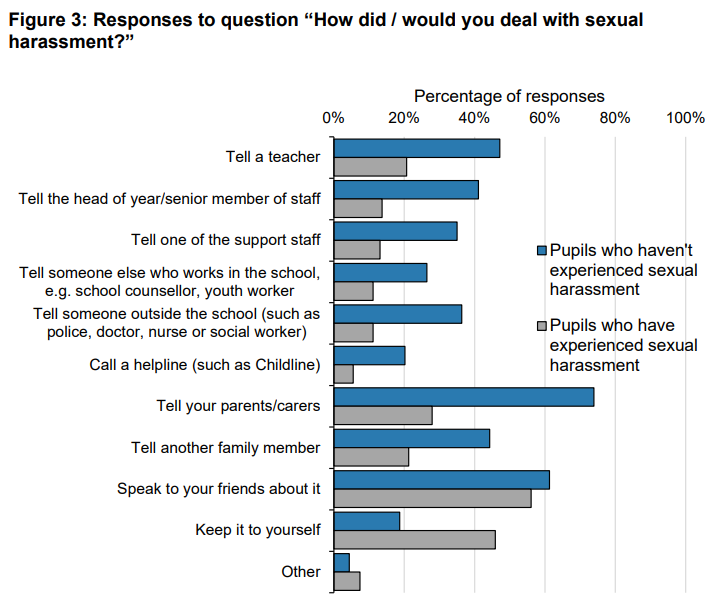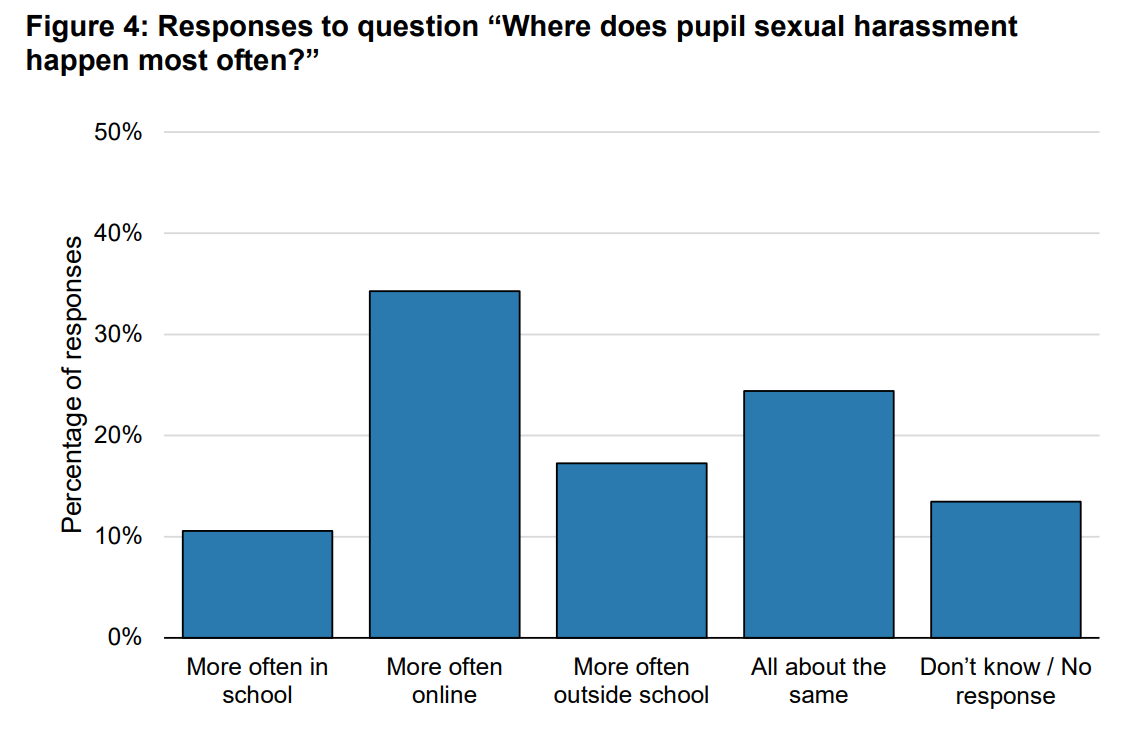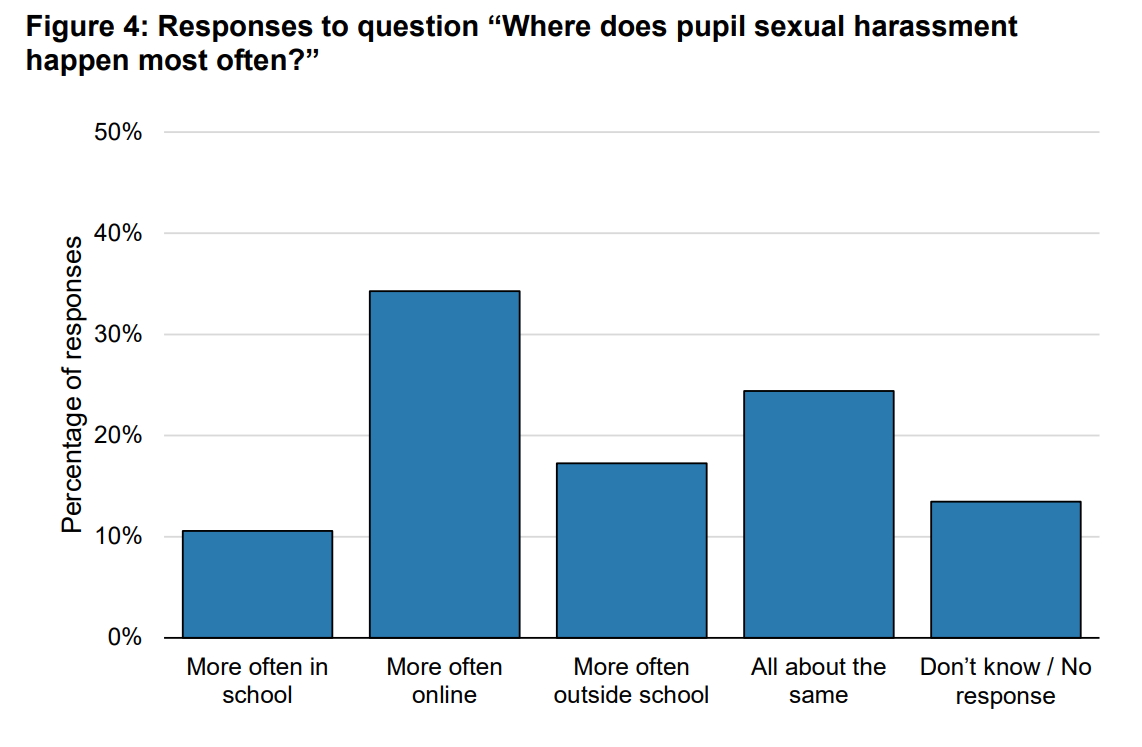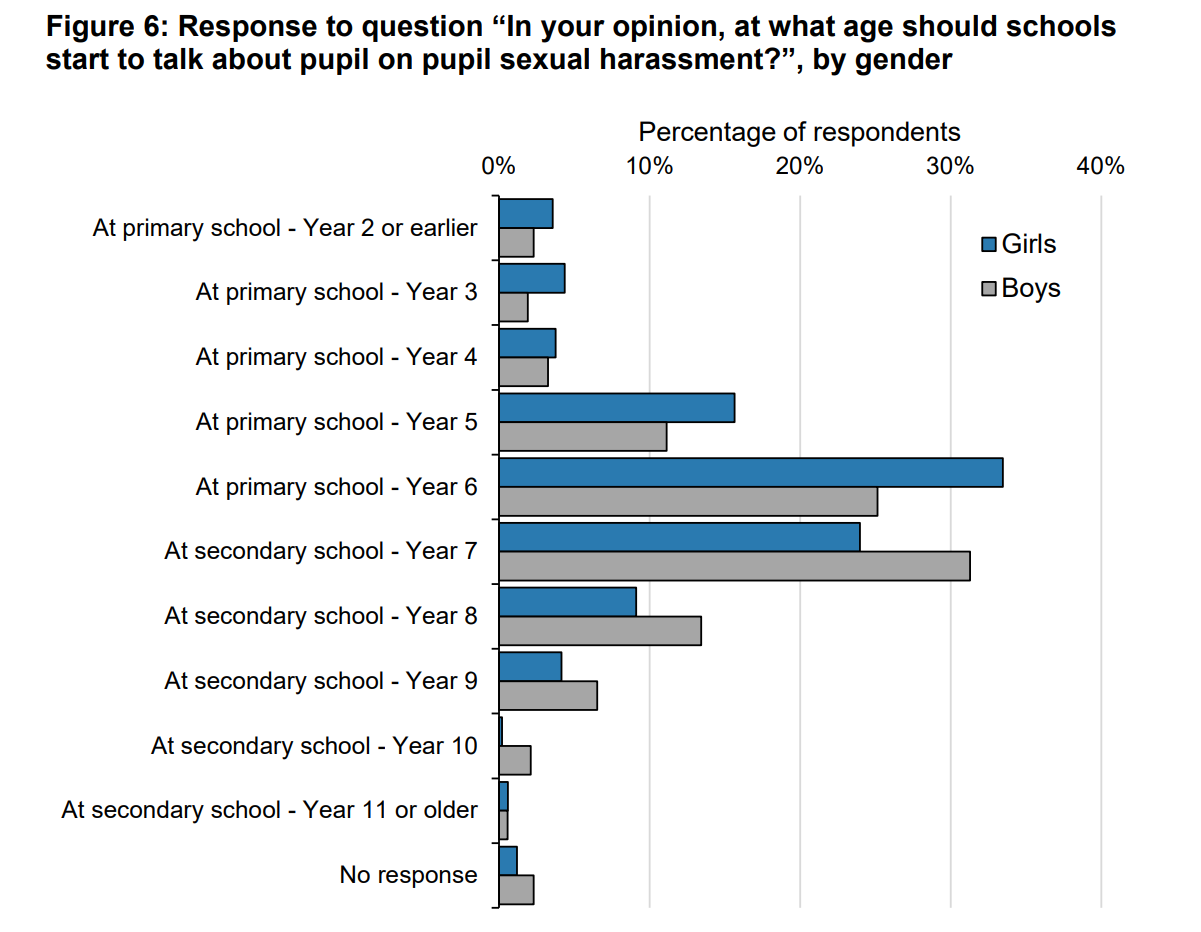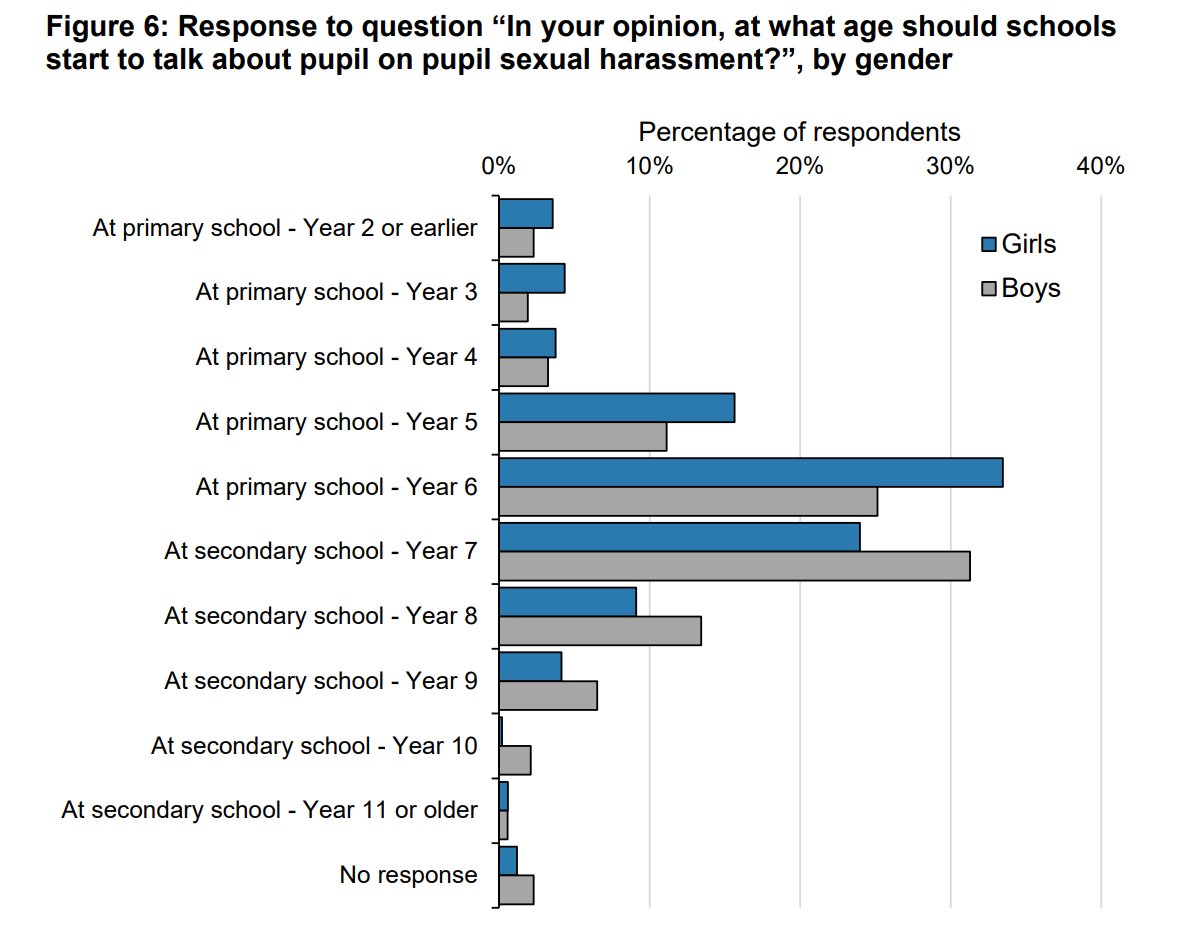We asked pupils who answered that they had personally experienced peer-on-peer sexual harassment about the type of harassment they had experienced and also when this first happened. We listed the following types of harassment:
- Hurtful sexual comments remarks or jokes
- Hurtful comments about someone’s body that cause distress
- Hurtful comments about someone’s clothes or looks that cause distress
- Sending texts or social media messages containing sexual wording that cause distress
- Sharing a nude/semi-nude photographs or video without the consent of the person pictured
- Sending unwanted sexual/explicit or pornographic photographs/videos to someone
- Lifting up skirts or taking a picture under a person’s clothing without them knowing
- Sexual assault such as forced kissing, unwanted sexual touching
Of those that reported personal experience, most pupils report that harassment started in secondary school than at primary school. Some forms of harassment involving social media, sending or sharing pictures, and explicit videos, occur more often outside of school than inside. Making hurtful comments is the most common form of sexual harassment.
In general, fewer male pupils who report having experience with sexual harassment report on each of the individual categories. This suggests that female pupils are more likely to experience multiple types of the sexual harassment and at a higher rate than male pupils. Male pupils, like female pupils, also report the harassment beginning in secondary school more than at primary school.
Those who did not select male or female who have personally experienced harassment report higher incidences of hurtful comments and sexual assault than pupils who selected a gender.
Table 2: Responses to question “What kind of harassment or abuse have you personally experienced, and when did it first happen?”
|
|
At primary school
|
At secondary school
|
Outside school, whilst I was in primary School
|
Outside school, since I've been in secondary school
|
|
|
Boys
|
Girls
|
Boys
|
Girls
|
Boys
|
Girls
|
Boys
|
Girls
|
|
Hurtful sexual comments remarks or jokes
|
20%
|
17%
|
61%
|
66%
|
15%
|
15%
|
52%
|
62%
|
|
Hurtful comments about someone’s body that cause distress
|
24%
|
32%
|
61%
|
70%
|
16%
|
25%
|
47%
|
57%
|
|
Hurtful comments about someone’s clothes or looks that cause distress
|
20%
|
29%
|
53%
|
64%
|
17%
|
22%
|
49%
|
53%
|
|
Sending texts or social media messages containing sexual wording that cause distress
|
4%
|
8%
|
38%
|
41%
|
9%
|
11%
|
52%
|
59%
|
|
Sending unwanted sexual/explicit or pornographic photographs/videos to someone
|
3%
|
6%
|
28%
|
29%
|
5%
|
7%
|
44%
|
51%
|
|
Sharing a nude/semi-nude photographs or video without the consent of the person pictured
|
3%
|
2%
|
22%
|
28%
|
4%
|
3%
|
29%
|
38%
|
|
Lifting up skirts or taking a picture under a person’s clothing without them knowing
|
3%
|
4%
|
10%
|
22%
|
3%
|
2%
|
13%
|
14%
|
|
Sexual assault such as forced kissing, unwanted sexual touching
|
3%
|
8%
|
23%
|
26%
|
5%
|
7%
|
24%
|
36%
|
Pupils who say they have a disability are much more likely to have received hurtful comments that started outside school when they were in primary school than the general population.
Pupils were invited to provide additional comments if they wished to. Most comments relate to sending and sharing unwanted message and images online. The behaviour of boys is highlighted, along with the reaction of teachers when complaints of such behaviour are made. Both male and female pupils highlight the behaviour of boys, but more girls reference this than boys. Those that do not consider themselves either male or female also highlight the behaviour of boys in particular.
Additionally, only girls note the negative reaction of teachers in such situations. Girls more than boys note receiving unwanted messages, images and videos online that are of a sexual nature. Boys, girls and non-binary pupils all note receiving comments about their appearance. However, a higher percentage of male and non-binary pupils highlight this issue more in the comments box.
In terms of types of peer-on-peer sexual harassment pupils have seen other pupils experience, receiving hurtful comments is the most featured type. Most of the harassment is first seen in secondary school and a variety of sexual harassment categories are seen by pupils. Online harassment is most likely to be seen outside of school for secondary pupils.
In general, female pupils are more likely to see a wider variety of pupil harassment than male pupils. This is similarly true for those who have not selected male or female. Older pupils are more likely to have seen a wider variety of harassment inside and outside secondary school.
Table 3: Responses to question “What kind of harassment or abuse have you seen others experience, and when did it first happen?”
|
|
At primary school
|
At secondary school
|
Outside school, whilst I was in primary School
|
Outside school, since I've been in secondary school
|
|
|
Boys
|
Girls
|
Boys
|
Girls
|
Boys
|
Girls
|
Boys
|
Girls
|
|
Hurtful sexual comments remarks or jokes
|
19%
|
19%
|
64%
|
77%
|
14%
|
14%
|
55%
|
62%
|
|
Hurtful comments about someone’s body that cause distress
|
23%
|
29%
|
61%
|
76%
|
17%
|
21%
|
49%
|
63%
|
|
Hurtful comments about someone’s clothes or looks that cause distress
|
22%
|
30%
|
54%
|
72%
|
18%
|
20%
|
45%
|
61%
|
|
Sending texts or social media messages containing sexual wording that cause distress
|
6%
|
7%
|
46%
|
47%
|
7%
|
8%
|
49%
|
61%
|
|
Sending unwanted sexual/explicit or pornographic photographs/videos to someone
|
3%
|
3%
|
36%
|
38%
|
4%
|
3%
|
39%
|
53%
|
|
Sharing a nude/semi-nude photographs or video without the consent of the person pictured
|
3%
|
2%
|
30%
|
36%
|
4%
|
3%
|
36%
|
47%
|
|
Lifting up skirts or taking a picture under a person’s clothing without them knowing
|
4%
|
5%
|
16%
|
25%
|
2%
|
2%
|
13%
|
23%
|
|
Sexual assault such as forced kissing, unwanted sexual touching
|
7%
|
8%
|
24%
|
36%
|
4%
|
6%
|
27%
|
39%
|
From pupils’ comments, we can see that most pupils claim to have seen or heard of some form of sexual harassment or assault. For those referring to sexual assault, the majority stated that they did not understand that it was assault at the time. The behaviour of boys is highlighted as a particular issue here again. A higher percentage of girls than boys refer to the behaviour of boys when discussing the sexual harassment of others. This is also highlighted by non-binary participants. Interestingly, in the comments box, it is only girls who describe experiencing negative comments about appearance.


